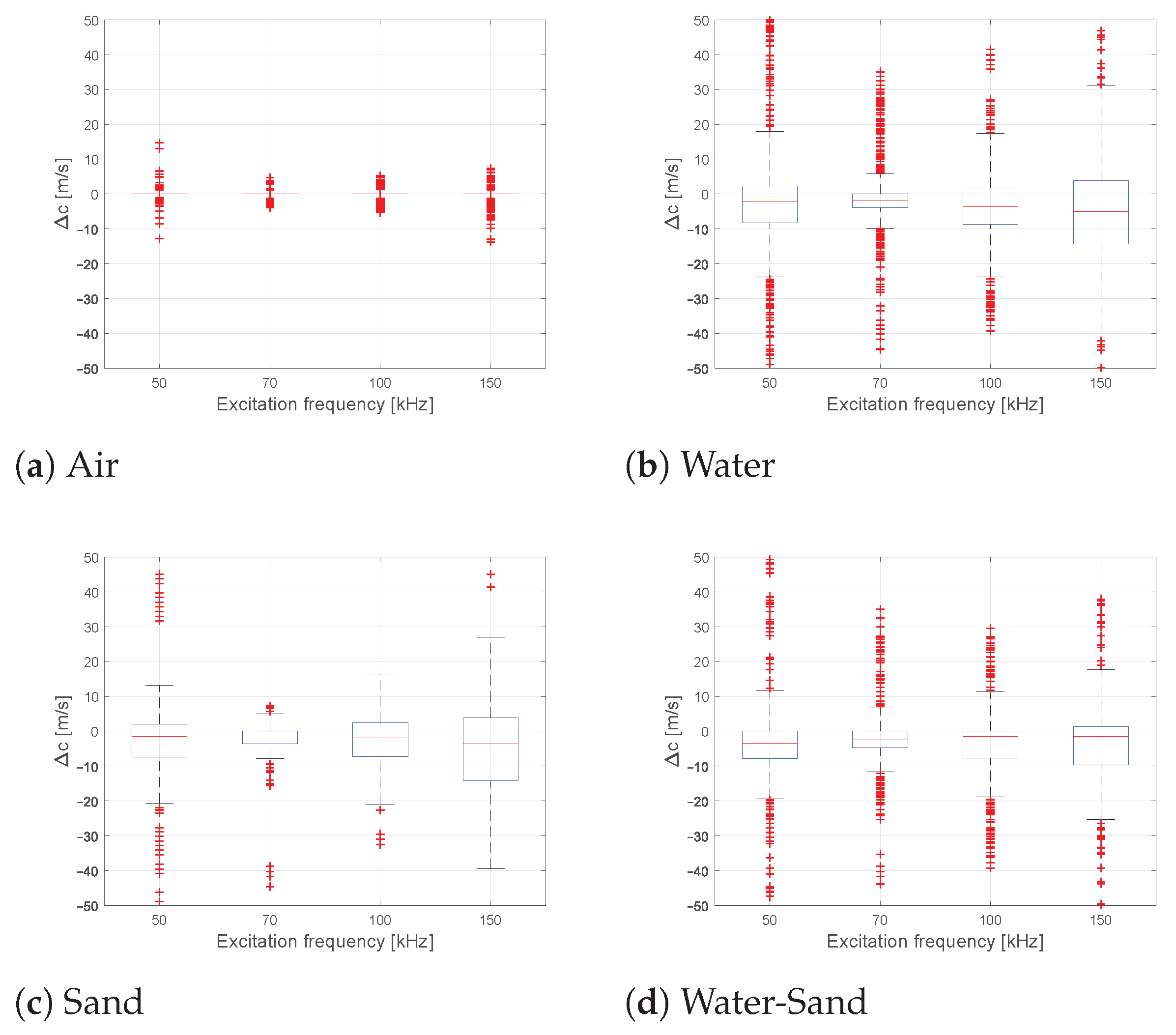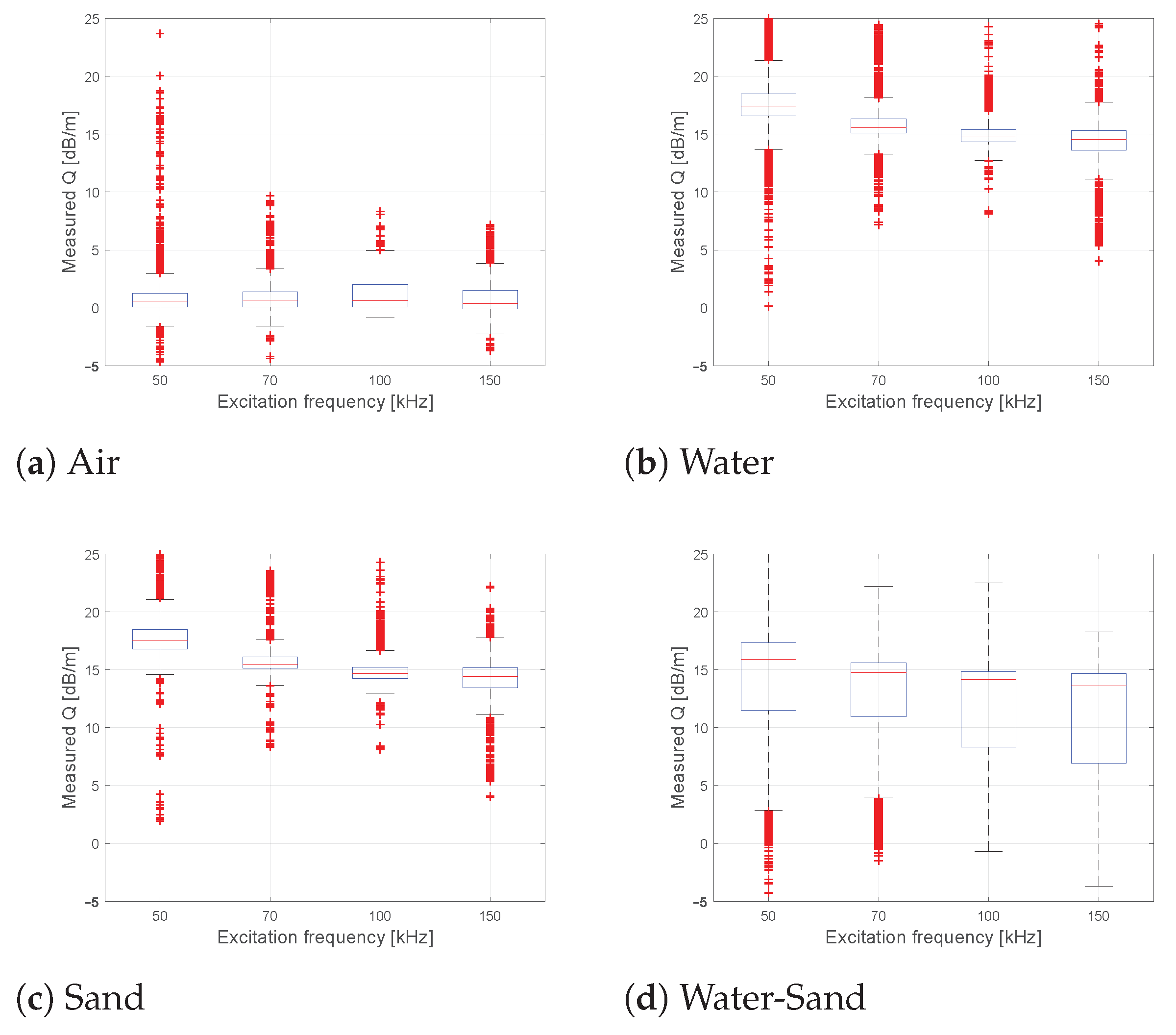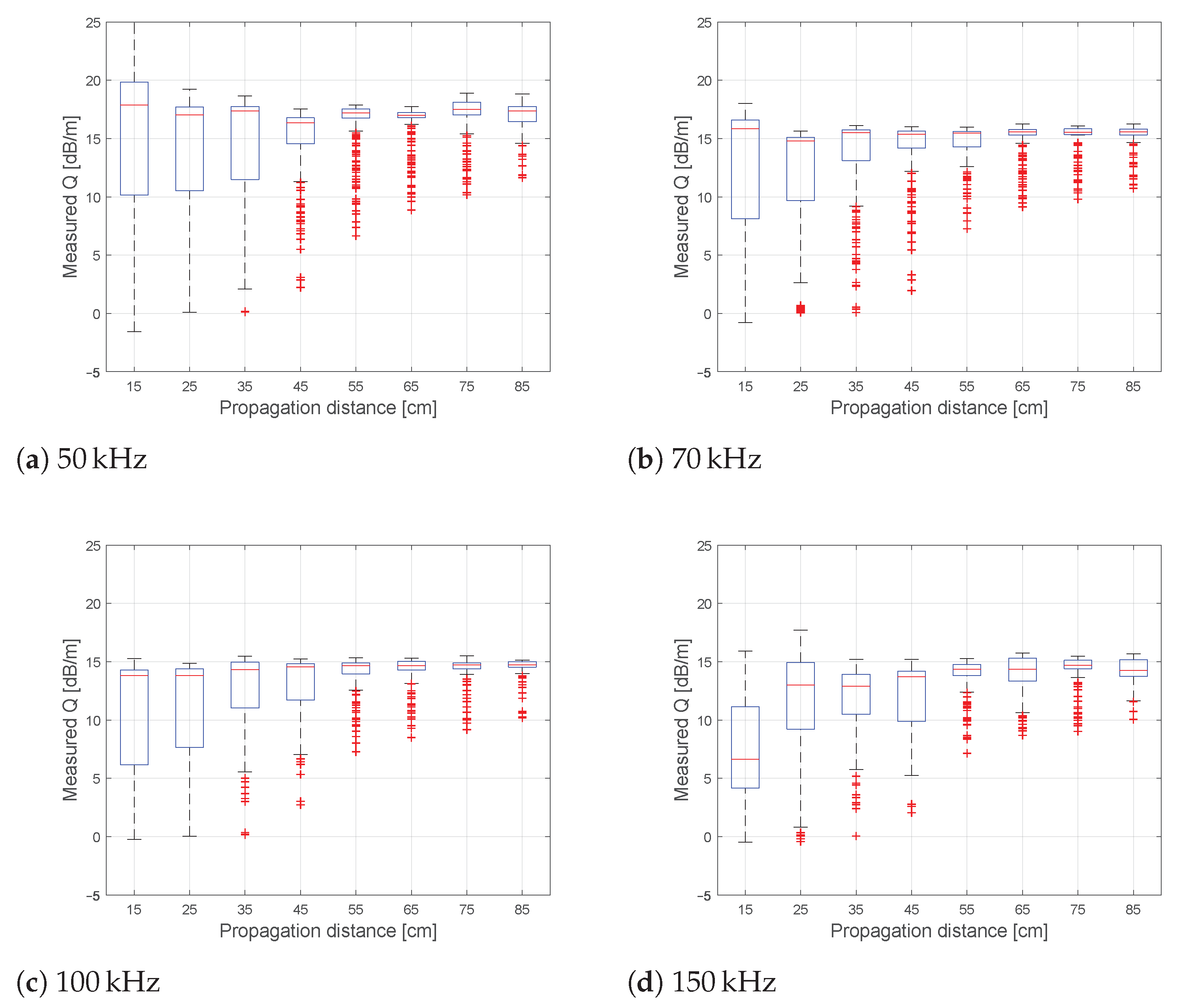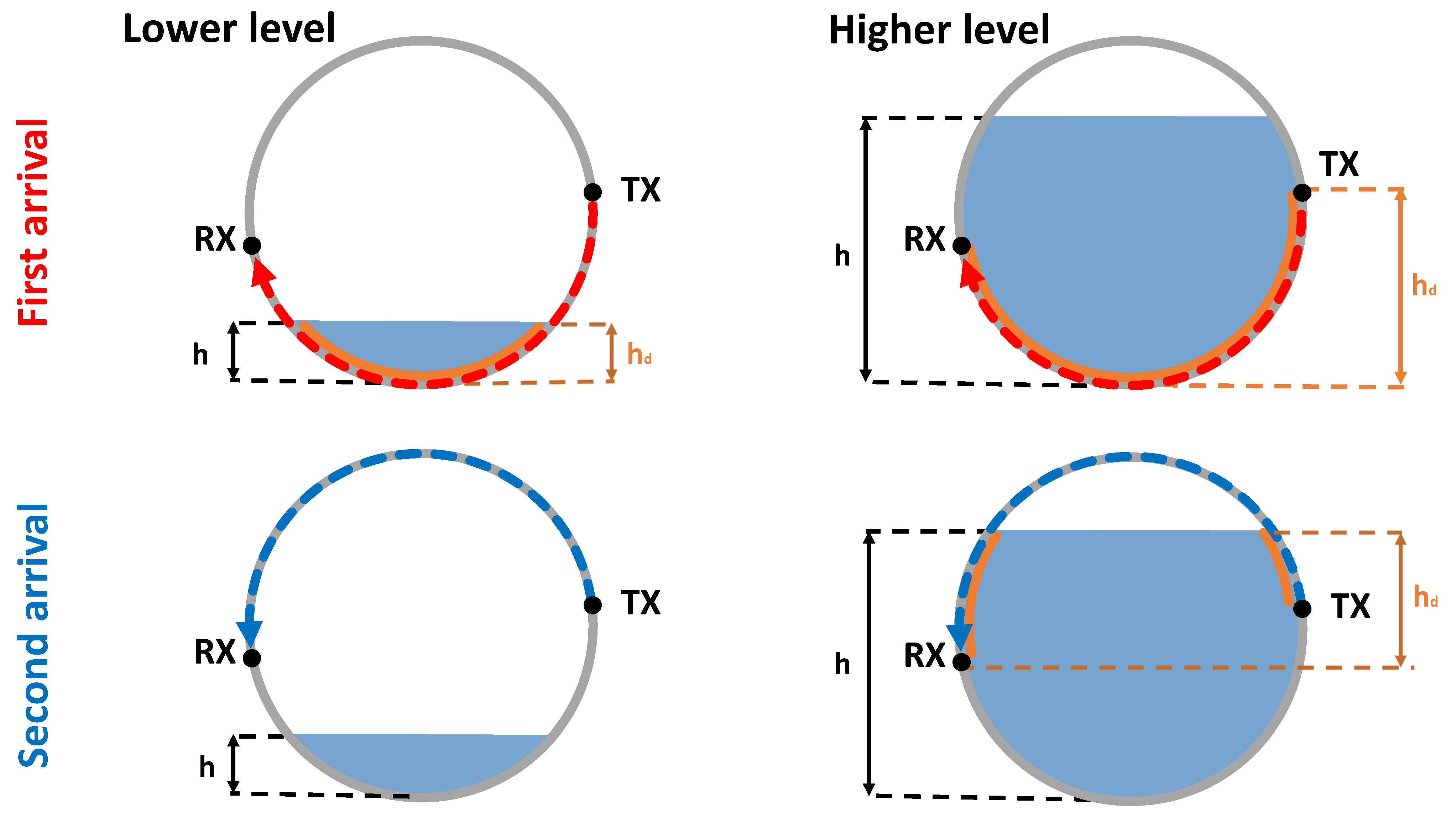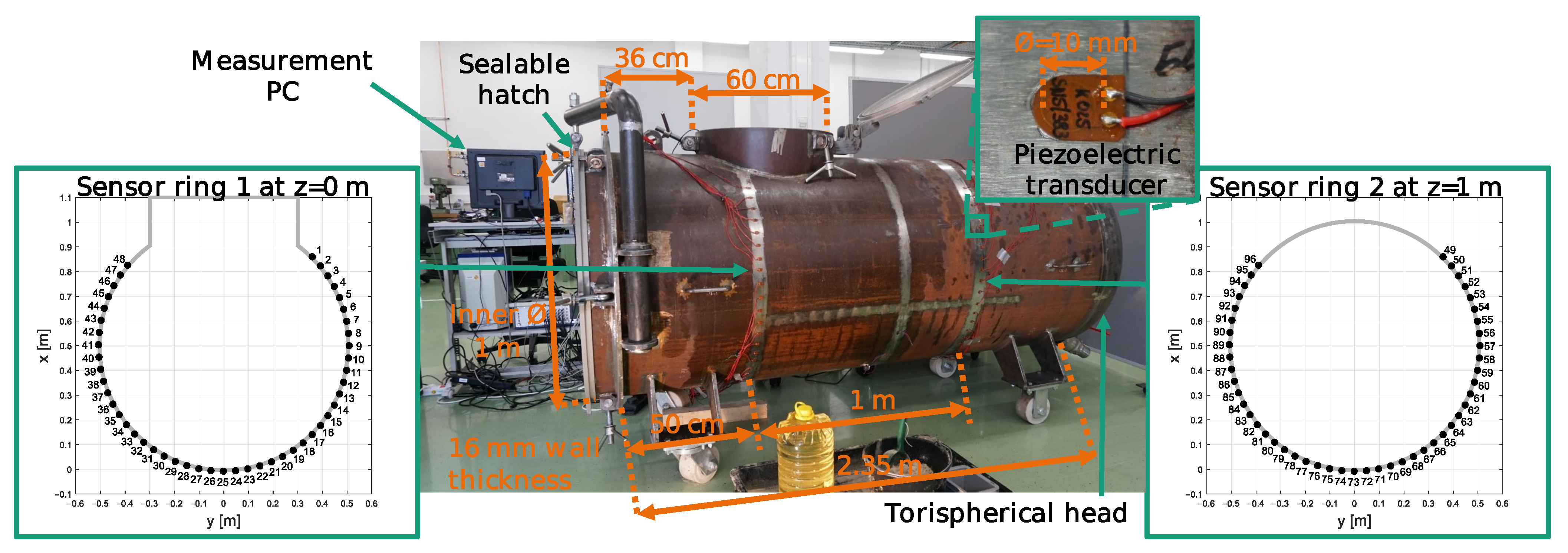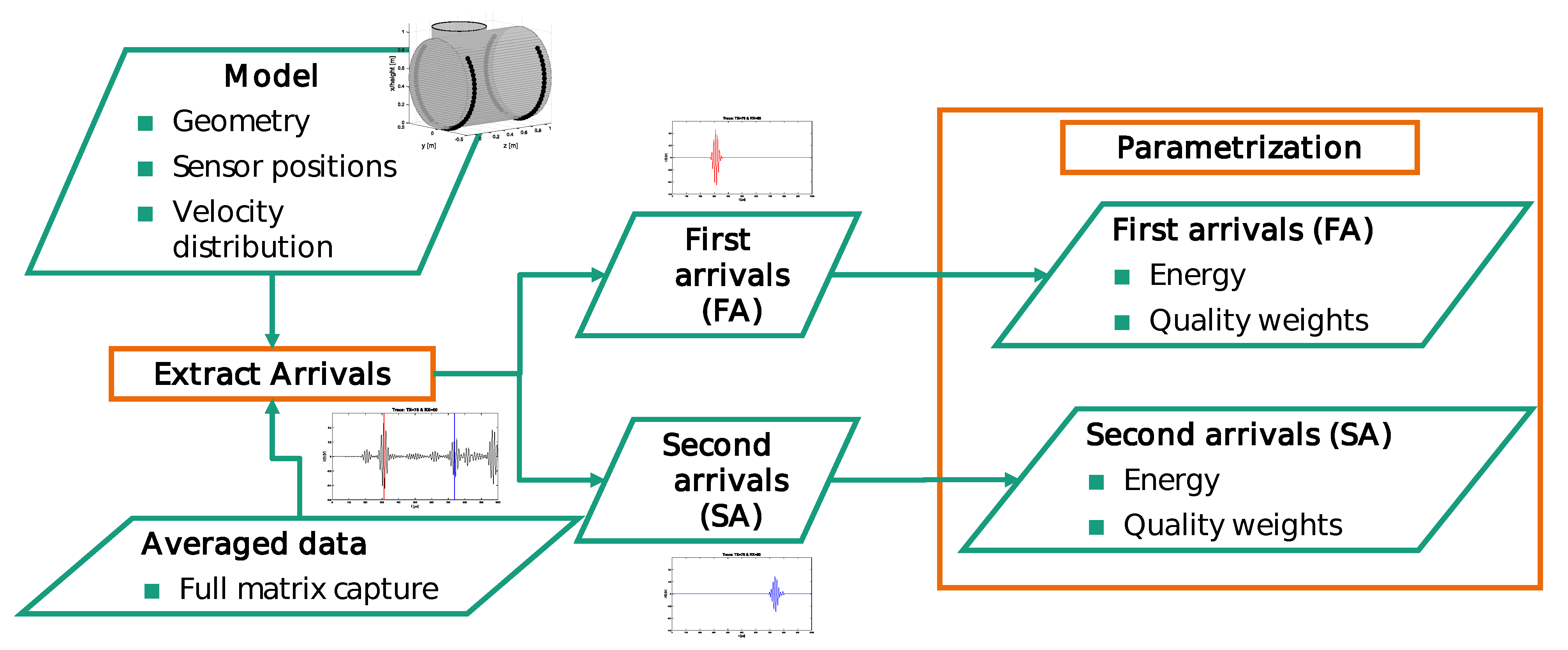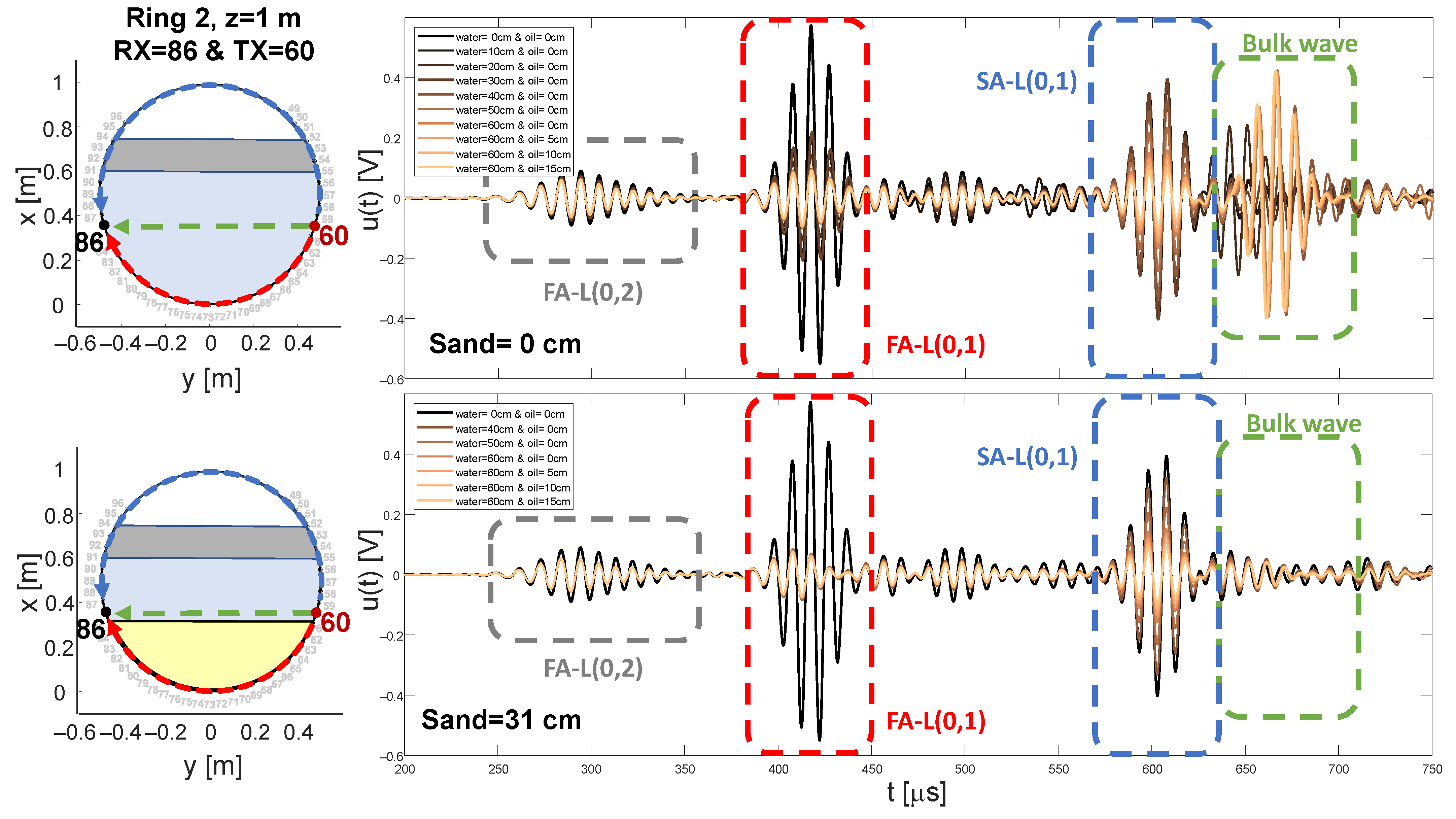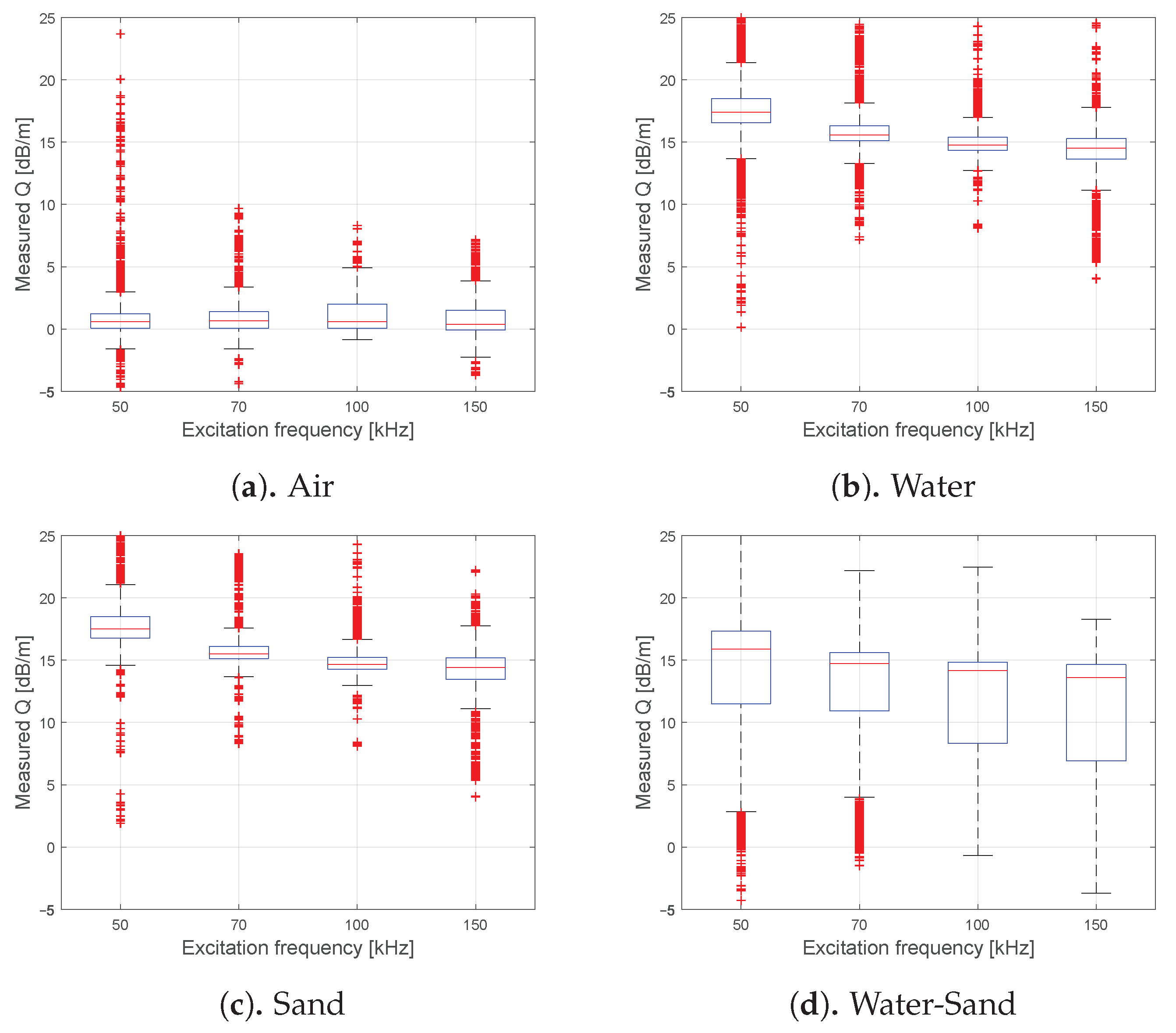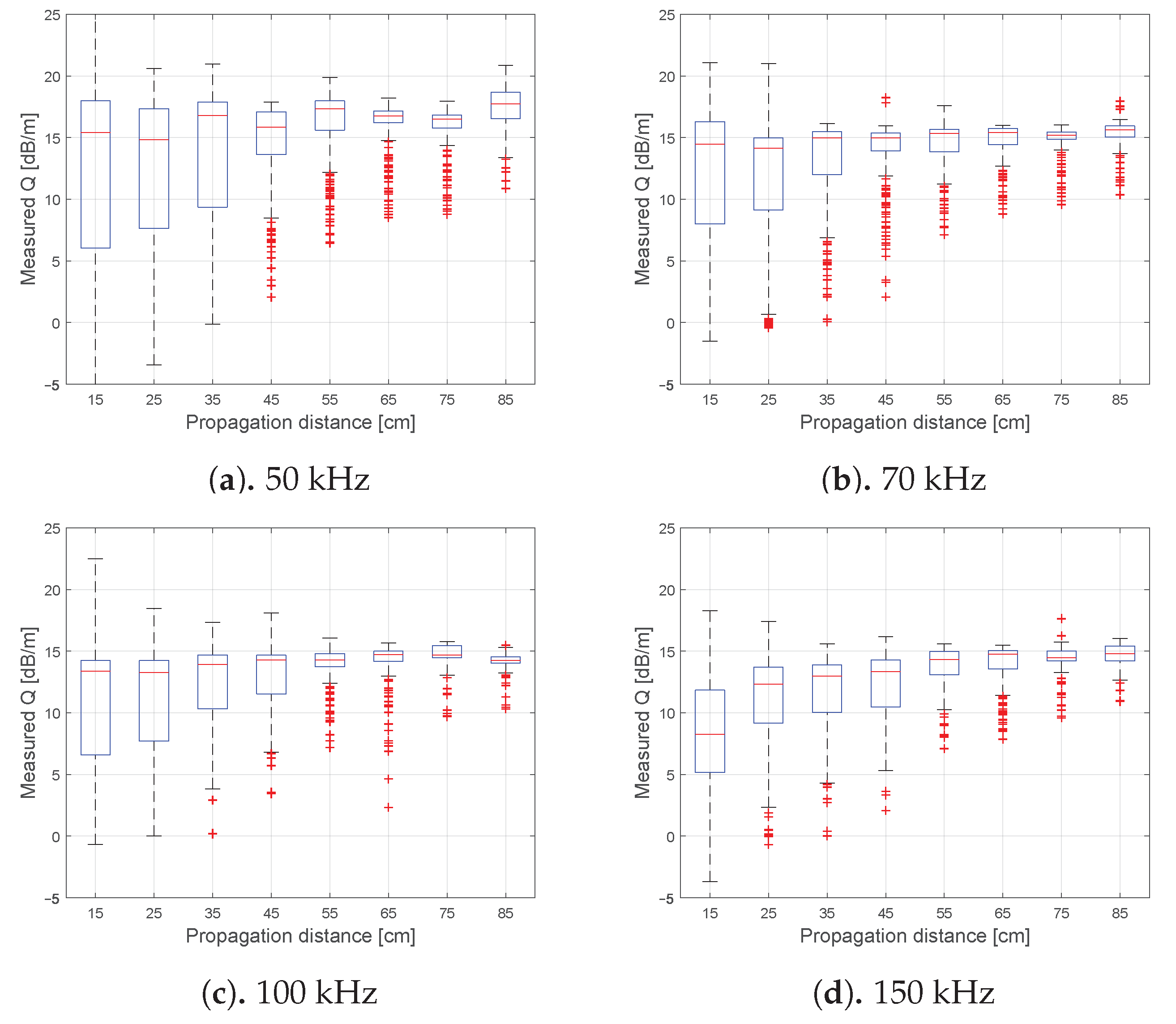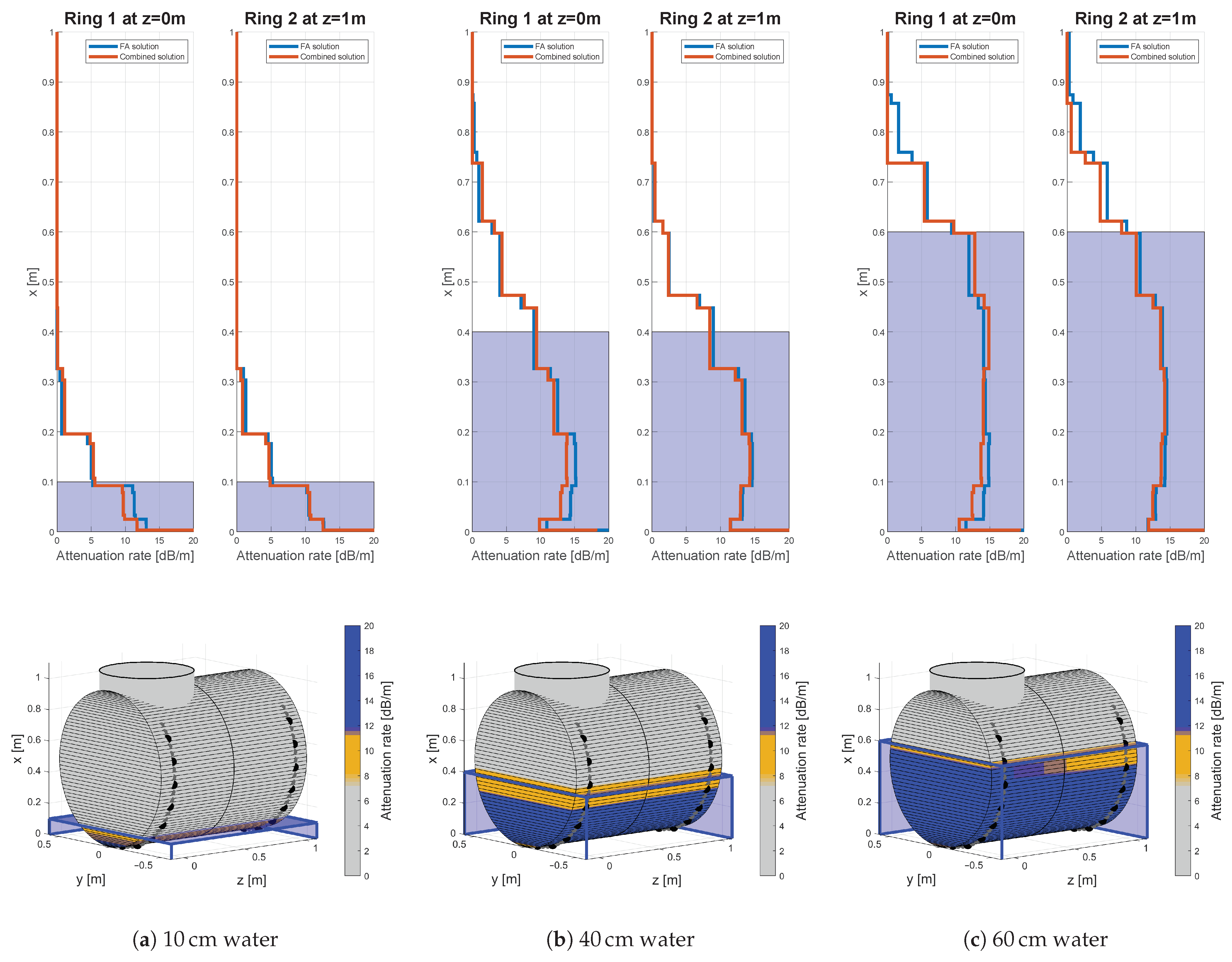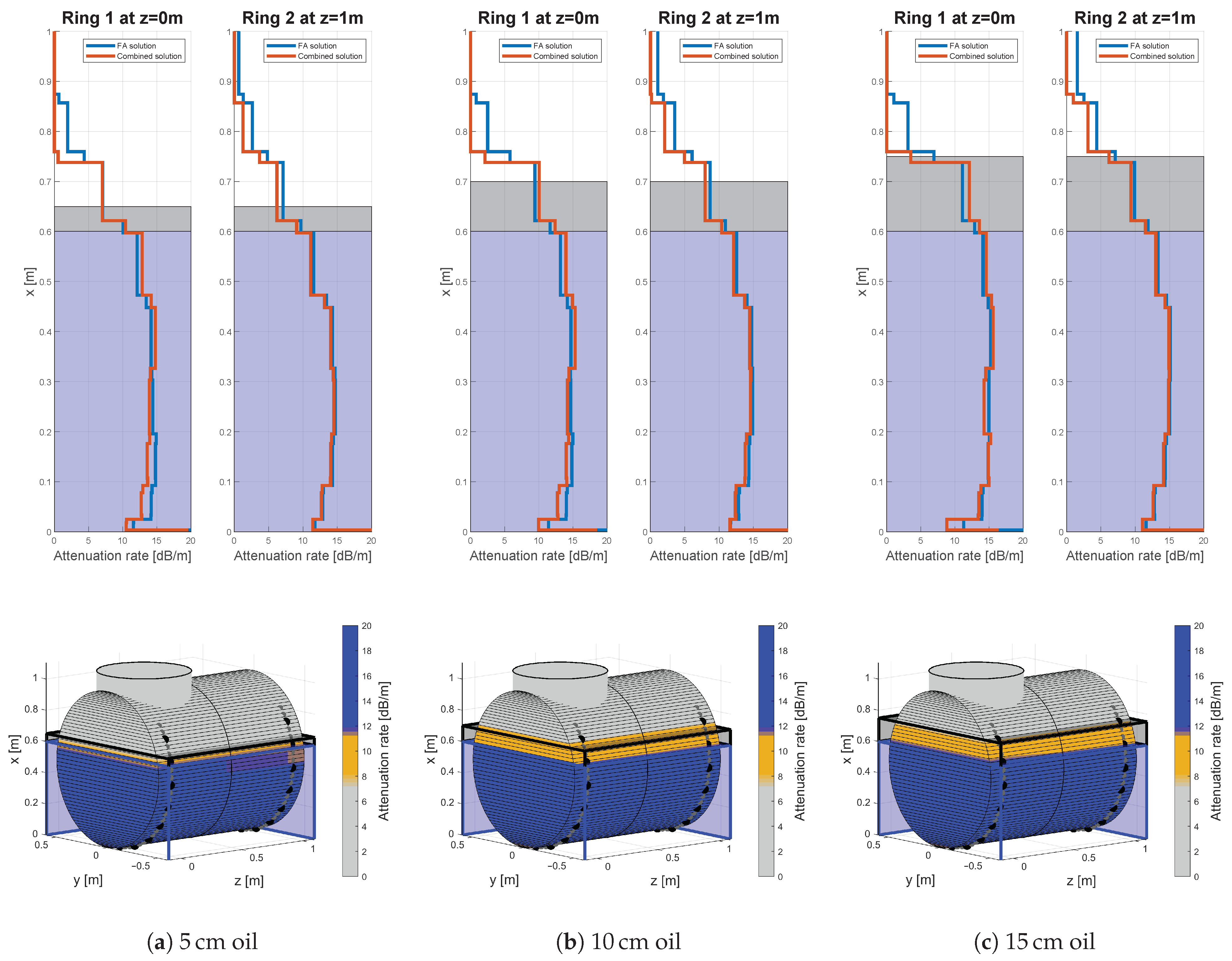1. Introduction
Separator vessels are generally objects with a cylindrical-shaped shell, vertically or horizontally aligned and consisting of normally high-grade materials. They divide various phases of oil and gas from the injected media by gravity. Depending on the architecture of the purifying process and the specific vessel type, the injected media can vary from a three-phase mixture of hydrocarbons, (salt–)water and solids directly extracted from the well/reservoir itself, till a pre-separated two-phase media mainly consisting of water, oil and gas of a cascaded process in later stages [
1]. Since the recovered reservoir fluid itself is under high pressure, the first stages of the separation are as well, while with each processing stage the operation pressure is decreasing. Beside adjusting the operation pressure and temperature, the efficiency of a separation process can be controlled by the flow rate, adding of chemicals, drainage and finally by turn-around cycles. All those factors and therefore the complete operation efficiency and safety can profit from an accurate knowledge of the height levels in each separation phase.
Although in most operating countries the construction, the quality control and maintenance by Non-Destructive Evaluation (NDE) is regulated by the American Society of Mechanical Engineers (ASME) guidelines [
2], the estimation of the filling level itself is not included. Nevertheless, various NDE methods can be found in the outlining literature [
3,
4]. Different techniques especially concerning separator vessels, summarizing their advantages and drawbacks are discussed in [
3,
5,
6]. Based on those investigations,
Table 1 illustrates an updated overview, including the following literature research.
In the context of separator vessels, displacers [
4,
7], pressure sensors [
8,
9], ultrasonic pulse-echo devices [
4,
7], electromagnetic radar [
8], electric capacity methods [
5,
6,
10,
11,
12] and various approaches of gamma ray methods [
7,
13,
14,
15,
16] have proved their applicability for height evaluation.
Displacers are submerged floating bodies with a defined density between two phases of interest. If the transition level is changing, the resulting buoyant force is captured by a reading device. Multiple phase-levels can be detected, by adding multiple displacers with different densities. However, these devices tend to fail in the unexpected presence of foam or emulsion since their presence effects the pressure gradient along an interface [
13]. Additionally, solid phases like sand, clay or wax cannot be monitored accordingly to the working principle. The last limitation applies for pressure sensors as well. Both methods are contact-based and need direct access to the vessels content, which is generally realized by additional bridles or bypasses, which could fail in recreating the exact conditions inside the vessel.
Other methods such as radar or ultrasonic pulse-echo devices need to be instrumented at least partly inside a vessel. Ultrasonic devices are generally based on time-of-flight measurements and are commonly used to measure the gas-liquid transition height [
4,
7]. However, the attenuation rates due to geometrical spreading and scattering losses of bulk waves are decreasing the penetration depth significantly and require an enhanced power source, if deeper phase transitions should be monitored. Moreover, their main disadvantage is that the scattering effect of rough surfaces as foam or emulsion are disturbing the measurements or at least attenuates the pulses significantly. On the other hand, lAlshaafi et al. [
17] used this effect as a separate measurement contrast to track those emulsion layers. In contrast, radar applications are using electromagnetic waves in the gigahertz spectrum and are based on the contrast in the relative permittivity, which is relatively stable over a wide range of process temperature and pressure. Such a system is usually arranged as non-contact pulse radar [
4], comparable to the ultrasonic measurements, or with an additional antenna in contact with the filling as guided radar [
4,
8]. The latter has proven its capability even for the solid phase, if the antenna is not exceeding a certain length and is free of residual products as wax or hardened clay.
Hjertaker et al. [
7] provided the combination of electrical, ultrasonic, thermal and gamma ray methods for three-phase hydrocarbon separators and introduced the term of tomometry, meaning multipoint cross-sectional metering aiming to acquire information on the cross-sectional flow-component distribution. Skeie et Halstensen [
8] chose a comparable approach by combining measurements of multiple fixed relative pressure sensors and a guided radar system using multivariate calibration to increase the accuracy. Arvoh et al. [
9] proceeded the work with a single pressure sensor measuring while traversing from bottom to top of the vessel. Finally, the results of various regression schemes were compared with each other.
Despite the achieved success with each single measurement method, the combination of methods and elaborate processing schemes, there is so for no NDE standard that meet all requirements of the industry [
3]. Especially instrumenting existing three-phase separator vessels without any additional change in their design such as bridles, holes or instrumentations inside remains a task which is currently only realizable by gamma radiation devices or Electric Capacity Tomography (ECT). Isaksen et Nordvedt [
10,
11] proposed various tomographic reconstruction techniques to estimate flow distributions in pipelines. Bukhari et Yang [
5,
6,
12] added a calibration scheme, including low and high permittivity contrasts. Together with an a priori database the system can monitor air-oil and oil-water phase transitions in horizontal separators effectively. On the other hand, a static database implies that the filling content should not vary in ongoing measurements regarding its electrical properties, which can be critical in real operations. Also, ECT is not applicable to vertically aligned vessels without either loosing resolution or increasing the number of sensors and therefore the costs. Especially the latter impeded the technology from the commercial breakthrough for the specified use case. In contrast active radiometric measurements in the gamma ray spectrum have reached market maturity and are patented by several companies [
15,
16]. Generally, the technique requires no extensive data processing, nor it is complicated to adapt it to different geometries. The used radiation propagates as straight rays through materials with neglectable scattering and map the density along the propagation paths. The measurement itself is not directly influenced by the process temperature nor by potential hazardous substances and is therefore considered to be robust. Furthermore, a potential insulation can remain on the object because of its low mass density and the resulting neglectable influence in the data. However, the major disadvantage of the system is the radioactive source itself, which requires proper radiation protection precautions, such as personal evacuating the surrounding area during the measurements.
In the work at hand, another possibility for continuous level measurements by Guided Elastic Waves (GEW) is investigated. GEW are often also referred as Guided Ultrasonic Waves (GUW) and becoming increasingly popular for certain tasks of NDE. Their propagation in plate-like structures ensues lower geometrical damping rates than conventional bulk waves, which generally results in longer propagation distances and better signal–noise ratios [
18]. Several researchers already described the possibility of estimating the fluid filling level with GEW [
19,
20,
21,
22]. In this work the GEW amplitude decay, measured at an outer vessel shell and processed by attenuation tomography is used to determine the filling distribution. This approach is promising in terms of scalability and the capability to resolve all phase transitions. Previously patented systems are admittedly also using GEW, but process only the bulk wave time of flight [
23] or the change in resonance the frequencies [
24], which could have significant disadvantages for bigger vessel geometries, for changing process parameters or for the accuracy.
3. Experimental Validation
3.1. Experimental Set-up
The multi-phase filling level estimation by guided waves was validated by a mock-up scale experiment, which is shown in
Figure 2. The mock-up is an approximately 2.5 m long steel tank with a wall thickness of 16 mm and an inner diameter of 1 m, approximating a horizontal separator vessel without internals. One end of the mock-up is closed by a torispherical vessel head including an additional 3” ball valve with a drain. The other side contains a flange with a waterproof sealable hatch. Near this hatch a cylindrical-shaped nozzle on the top side is located, with an inner diameter of 30 cm and a height of 10 cm, measured from the top peak of the cylindrical surface as reference. It is also sealable by a waterproof hatch. The inner surface is coated by anticorrosive paint.
The outer surface of the mock-up was instrumented with two rings, each consisting of 48 circular shaped piezoelectric patch transducers of the type P876-K025 from the company PI-ceramics. Those patch transducers have a diameter of 10 mm, a thickness of 0.2 mm and an electric capacity of 3.8 nF. Each patch was glued with a two-component adhesive to the beforehand polished vessel surface. During the hardening, magnets were used to ensure a constant contact force. The transducers of each ring have an equidistant spacing of 5 cm, in relation to the outer circumference. Each ring is covering the bottom 85 cm of the inner height, whereby the upper 15 cm were uncovered due to the presence of the top nozzle at one ring. In the following, the ring near the top nozzle will be referred as ring 1 and the other one as ring 2 for the sake of clarity.
A measurement contains the transmitted signals from each sending to each receiving transducer (full matrix capture) for a certain excitation signal and a possible filling distribution. The excitation signals were Hann-windowed five cycle cosine functions (RC5) of either 50, 70, 100 or 150 kHz. To enhance the signal-to-noise ratio, each measurement was repeated 64 times and mean values were calculated afterwards. For each sample, a standard deviation was calculated beforehand and only signals with all samples within a 3.5 times standard deviation threshold were accepted. This processing step was added to remove undesired electrical noise.
Various combinations of sand-water-oil fillings were measured, which can be obtained from
Table 2. Before starting the filling process an empty baseline measurement was obtained for all excited centroid frequencies. The tank was filled consecutively with an increasing water height by 10 cm per measurement. After reaching 60 cm water height an additional oil layer was introduced consecutively by 5 cm thick layers, till the total top-level reached a height of 75 cm. The oil consisted of commercially available sunflower oil representing a crude oil layer. Subsequently, the vessel was emptied and the whole process repeated with various distributions of finely grained quartzite sand, whereby the last sand filling built in with an artificial
slope, which was fixed by an additional construction fleece. The grain size of the sand was within the range of 0.1 up to 0.3 mm. All height values were controlled by a meter stick and an ultrasonic pulse-echo device placed at the top hatch.
3.2. Data Processing
For the attenuation tomography, the vessel was represented by two one-dimensional height versus attenuation rate distributions. Each distribution was associated with one sensor ring. Therefore the inner height was sampled, so that the outer circumference is nearly equidistantly sampled by 1 cm cells. The deviation from a perfect equidistance results from the symmetry condition splitting into left and right circumference. The whole system implies only circumferentially acquired measurements for each ring separately, as discussed in
Section 2.2. For the data preprocessing an analytic model of a steel hollow cylinder with a wall thickness of 16 mm was used. Based on the model, the time of flight, the level of waveform spreading and the attenuation due to geometric spreading were estimated beforehand, as shown by
Figure 3. According to those parameters, a window function for each mode and arrival of interest was defined as:
with the Blackmann function flanks:
The beginning
and endpoint
mark the points in time, at which the estimated analytic waveform has decayed below
of the peak value after propagation along its path. A signal passing through in between the interval. The signal is flattened by a Blackmann function
outside the interval and within the period of
. All other time sections are suppressed.
is the characteristic period of the originally excited centroid frequency. As a result, the signal energy
E of a certain mode arrival of a measured signal
can be extracted by:
This approach has the advantage of being simply adaptable to more complex numerical models and acknowledging the attenuation in a broader bandwidth than only picked peak values, to make the method more robust against waveform deformation.
The first and second arrival of the fundamental antisymmetric lamb mode were extracted. Values deriving from time sections with interference of both arrivals, meaning overlapping sections, were related to appropriated weights w in the equation system. For example, for a sender-sensor combination half the circumference apart from each other overlaps exactly, therefore the retrieved energy is associated with the second and first arrival with . Since the analytic model did not contain the influence of the nozzle at ring 1, any back wall or welded seams, higher modelling induced errors are expected in the picked energy values and final solution of the optimization problem of ring 1 compared to ring 2. Due to sensor arrangement, it is expected that solution and data retrieved from the second arrival are stronger influenced by this effect.
Solutions for the solely first arrival data and combined data from the first and the second arrival were computed. In the combined solution all entries of the second arrival were penalized by additional
in
. This step can be justified due to longer propagation paths and the corresponding lower energy values, which finally result in a lower signal-to-noise ratio. Also, the likelihood of interference with other modes, reflections and converted bulk waves is increasing on later arrivals. The solution was calculated with an iterative Least SquaRes solver (LSQR) of [
39], which is part of the Linear Algebra PaCKage LAPACK. As a starting model an empty tank was assumed.
For each filling combination, excitation frequency and sensor ring, the solution was calculated for artificially reduced sensor networks, giving equidistant spacings of 5, 10, 20 and 30 cm. All possible combinations of shifting the network were considered likewise for each reduction step. From each single attenuation rate four different height levels were extracted, namely water-, oil-, sand- and top-level. The latter refers to the upper liquid level without distinguishing between water and oil. Based on those results, statistically validated accuracies were calculated and are given in
Appendix B. The underlying attenuation thresholds for the level extraction were accordingly chosen to the first results. Those are explained in detail in
Section 4.2. Therefore, oil was in the range of 7.5 dB/m till 11.75 dB/m, whereby water was above. Sand was indicated by a significant drop in the attenuation rate at least below 11.75 dB/m, but necessitated an estimated water phase above. The rules applied for all excited centroid frequencies and both sensor rings likewise.
5. Discussion and Conclusions
In the work at hand, the estimation of multi-phase height levels by attenuation tomography with guided elastic waves was realized. The investigated case was a small-scale horizontal separator vessel filled with various distributions of sand, water and oil, whereby piezoelectric transducers were mounted on the outer shell. The results show a reliable and accurate system regarding the top and sand level with accuracies in the centimeter range for a sensor spacing of 15 cm. The ability of exactly distinguishing between water and oil suffers from higher inaccuracies due to low contrast in the attenuation rate. The median error is in the lower centimeter range, whereby the 32nd to 68th inter percentile distance is in the decadic centimeter range. However, already existing practicable solutions for estimating fluid phase transitions could be added to enhance the results further by defining additional constraints in the optimization problem.
The proposed technique is based on attenuation amplitude measurements by picking a specified wave mode and its arrivals and set them in relation to a baseline measurement. Therefore, a model-based approach was used which can be adopted to more complex geometries including nozzles or even internals. In the investigated frequency range, the filling showed no significant influence on the wave speed. Based on the analysis of the measurement data the attenuation rate of saturated sand and water were in the same range, whereby a phase transition between both phases added an unexplained mechanism, which caused a significantly decreasing attenuation rate. The proposed algorithm was able to resolve the phase transition. However, the appearance of bulk waves was observed for fluid fillings, whereas the presence of sand apparently damped the direct bulk arrivals. This behavior represents another possibly measurable contrast or addable information to enhance the accuracy of the system further. Basic assumptions regarding the filling distribution and sensor arrangement were made for the attenuation tomography. Those resulted in symmetry conditions which enabled a reduction of the model space to an independent one-dimensional optimization problem per sensor ring. Consequently, the calculated attenuation distributions were one-dimensional cross sections which coincide with the term tomometry introduced by [
7]. By combining the results from two sensor rings at different locations it was possible to resolve an artificial
sand slope and to estimate the fluid boundaries at the same time without further interconnections between the data. This and the excluded geometrical features at one of the used sensor rings indicate the robustness and reliability of the technique.
The investigated frequency-thickness product ranged from 800 to
and showed no significant influence on the accuracy for all fillings except for sand. However, this was significantly below the expected rate of
for the appearance of quasi-Scholte waves at a steel-water boundary [
36]. However, it seems possible to use the effect in further investigations to enhance the measurement contrast or to resolve rheological properties of oil or wax in the vessel.
For the investigated vessel geometry with an inner diameter of 1 m and a wall thickness of 16 mm, the 15 cm equidistant sensor spacing along the outer shell quantified as a reliable trade-off between accuracy and minimal instrumentation effort. For higher spacings, the accuracy is decreasing for the given tasks, whereas the pure top-level estimation was reliable even for investigated sensor spacings of up to 30 cm. In the current data processing only first arrivals and the combination of first and second arrivals of a specific guided wave mode were used. The latter gave no significant improvement of the accuracy for most investigated fillings. This circumstance was probably substantiated due to the lower signal–noise ratio of the SA arrivals. The exception was the estimation of the oil level, which possibly originates from the incomplete circumferential instrumentation at the upper 20 cm of the inner height of the test specimen. This results in a higher amount of SA travel paths along the upper height levels, where the oil levels were located for the investigated filling states. Consequently, for a full circumferential instrumentation this exception is expected to converge to an insignificant amount.
The system could be adopted to vertical separators, whereby a single vertical line long the vessel wall seems like a logical choice for a sensor arrangement. This would imply a simpler discretization scheme with a purely linear dependence on the filling height, which could possibly lead to a better numerical stability by a lower condition number. On the other hand, the additional information given by multiple arrivals would be not available.
Upcoming work should address the stability and influences in case of changes in the process parameters as temperature or pressure. The possibility of estimating residual wax layers or mixed phases as foam or emulsion should be evaluated. Additionally, the possibility of including structural features as internals or nozzles in the propagation paths by further processing such as ray tracing or eikonal solvers and its capable improvements in accuracy could be assessed. A further theoretical question is the underlying wave propagation mechanism along the water-sand phase transition for the investigated geometry and frequency range, which is causing the significant drop in the attenuation rate. The overall observed high data quality is a complied requirement for more elaborate processing schemes as full waveform inversion, which could acknowledge multiple modes at the same time, include complex mechanisms along phase transitions and eventually result in elastic and viscoelastic properties rather than in abstract attenuation rates.
